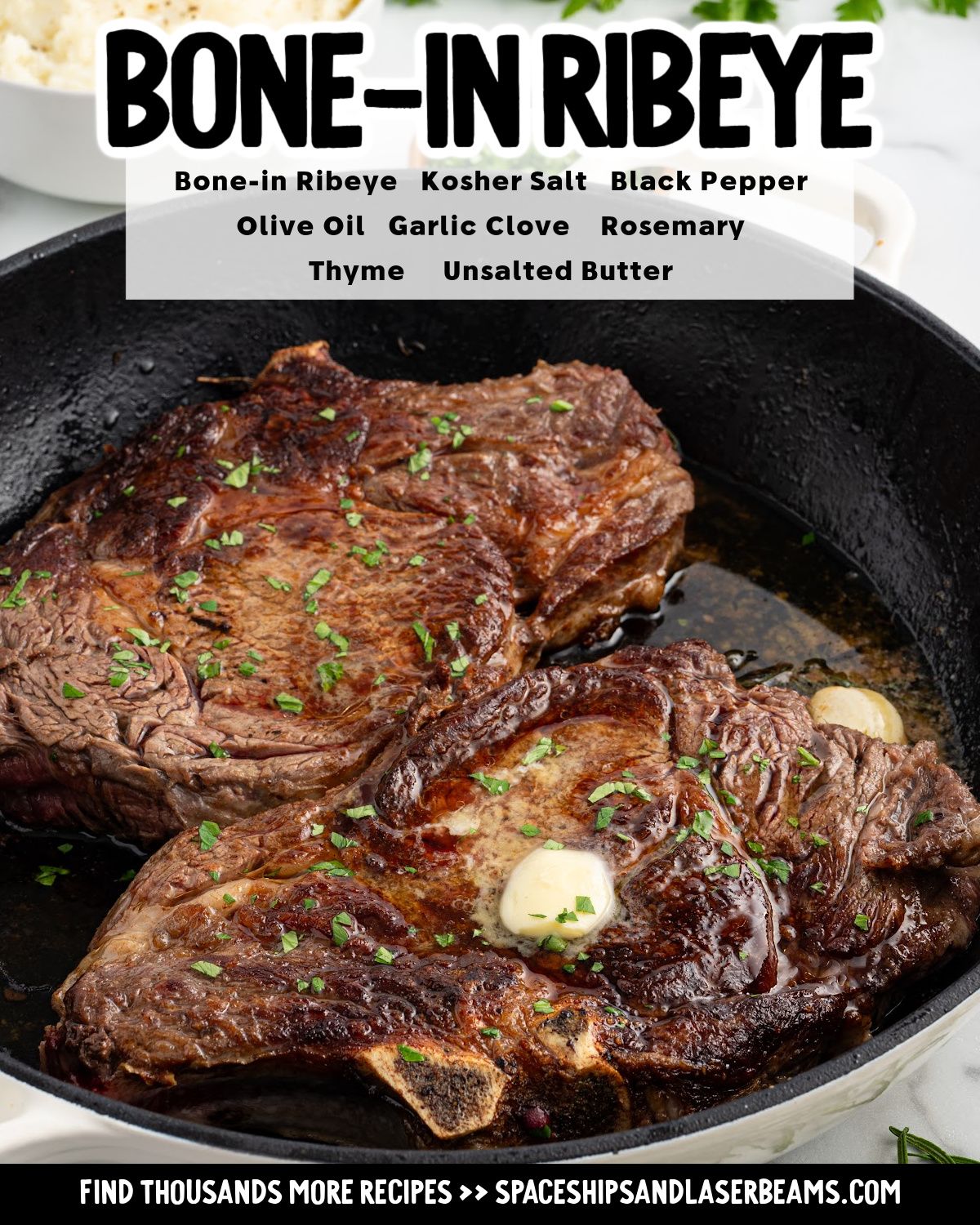ADVERTISEMENT
Instructions:
1. Bring the Steak to Room Temperature
Start by removing your bone-in ribeye steak from the fridge about 30-60 minutes before cooking. Letting the steak come to room temperature ensures that it cooks evenly, giving you a tender, juicy result.
2. Season the Steak Generously
Generously season both sides of the steak with kosher salt and freshly ground black pepper. If you like, you can also rub the steak with a bit of olive oil to enhance the flavor and create a nice crust. For extra depth of flavor, consider adding minced garlic, fresh thyme, or rosemary to the seasoning mix.
- Tip: For even more flavor, you can marinate the steak for a few hours or overnight, but a simple seasoning of salt and pepper usually yields the best results for a bone-in ribeye.
3. Choose Your Cooking Method
There are a few different ways to cook a bone-in ribeye, depending on your preference and equipment.
Grilling Bone-In Ribeye (The Classic Way)
Grilling is one of the most popular methods for cooking ribeye steaks, especially during the warmer months. Here’s how to get perfect results on the grill:
- Preheat your grill to medium-high heat.
- Brush the grates with oil to prevent sticking.
- Place the ribeye on the grill and cook for about 4-6 minutes per side, depending on the thickness of the steak and your desired doneness.
- Use a meat thermometer to check the internal temperature:
- Rare: 120°F (49°C)
- Medium Rare: 130°F (54°C)
- Medium: 140°F (60°C)
- Medium Well: 150°F (66°C)
- Well Done: 160°F (71°C)
- Once it reaches your desired temperature, remove the steak from the grill and let it rest for at least 5-10 minutes before cutting.
Pan-Seared and Oven-Finished Ribeye (Perfect for Indoor Cooking)
If you don’t have a grill or prefer to cook indoors, the pan-sear and oven method is a fantastic alternative. Here’s how to get that beautiful caramelized crust while ensuring the inside stays juicy and tender:
- Preheat your oven to 400°F (200°C).
- Heat a cast-iron skillet (or another oven-safe skillet) over medium-high heat. Add a tablespoon of olive oil or butter to the pan and allow it to heat up.
- Once the pan is hot, place the ribeye steak in the skillet. Sear for about 3-4 minutes per side, or until you get a nice golden-brown crust.
- After searing, transfer the skillet to the preheated oven and roast for about 5-7 minutes (depending on the thickness of the steak) until the steak reaches your preferred doneness.
- Let the steak rest for 5-10 minutes before slicing and serving.
Reverse Sear Method (Low and Slow)
If you want to ensure a perfectly even cook throughout the steak, the reverse sear method is an excellent choice. Here’s how to do it:
- Preheat your oven to 275°F (135°C).
- Place the seasoned ribeye on a wire rack over a baking sheet. Roast in the oven for about 20-30 minutes, or until the steak reaches an internal temperature of 120°F (49°C) for rare, or 130°F (54°C) for medium-rare.
- Once the steak has reached your desired temperature, remove it from the oven and let it rest for 5-10 minutes.
- Heat a cast-iron skillet on high heat, add oil or butter, and sear the steak on both sides for 1-2 minutes until a rich, golden-brown crust forms.
- Rest for a few minutes before slicing.
How to Know When Your Bone-In Ribeye Is Perfectly Cooked
The best way to check the doneness of a steak is with a meat thermometer. However, if you’re cooking by feel, here’s a simple guide to gauge your steak’s doneness by pressing on it:
- Rare: Soft and squishy (120°F or 49°C)
- Medium Rare: Firm but with a little give (130°F or 54°C)
- Medium: Firm with some resistance (140°F or 60°C)
- Medium Well: Firm and slightly resistant (150°F or 66°C)
- Well Done: Very firm with no give (160°F or 71°C)
Resting the Steak
After cooking, always let your bone-in ribeye rest for at least 5-10 minutes. This allows the juices to redistribute throughout the meat, ensuring a juicy and tender steak when you cut into it. Cutting into the steak immediately can cause the juices to run out, leaving the steak dry.
Serving Your Bone-In Ribeye
A bone-in ribeye makes an incredible main dish all on its own, but you can elevate the experience with a few simple accompaniments:
- Sides: Serve with roasted vegetables, mashed potatoes, or a fresh salad to balance the richness of the steak.
- Sauces: While a great ribeye needs little more than salt and pepper, you can pair it with sauces like béarnaise, chimichurri, or a simple garlic butter sauce to enhance the flavor.
- Wine Pairing: Pair your steak with a full-bodied red wine, such as a Cabernet Sauvignon, Malbec, or Syrah. The wine’s tannins will complement the rich, fatty flavors of the ribeye.
Final Thoughts
Cooking the bone-in ribeye steak is an art form, but with the right techniques, it’s incredibly rewarding. Whether you’re grilling outdoors or cooking indoors with a cast-iron skillet, the key to a perfect bone-in ribeye lies in seasoning, searing, and letting the steak rest. With its tenderness, juiciness, and unbeatable flavor, the bone-in ribeye will quickly become a favorite for steak enthusiasts.
So fire up the grill, heat your skillet, or preheat your oven—and get ready to savor the ultimate steak experience with a mouthwatering bone-in ribeye.
Enjoy your steak! 🥩🍷
ADVERTISEMENT
